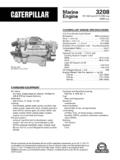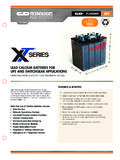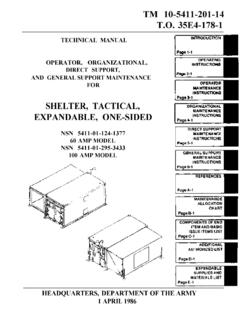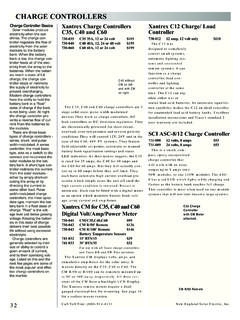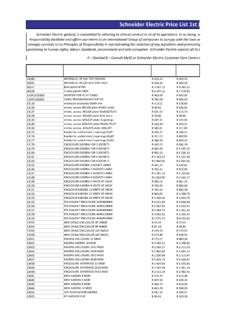Transcription of HAMTRONICS® R122 VHF AIR BAND R ECEIVER : …
1 2013 Hamtronics, Inc.; Rochester NY; USA. All rights reserved. Hamtronics is a registered trademark. Revised: 12/26/14 - Page 1 - GENERAL INFORMATION. Functional Description. The R122 Receiver is designed for small airports to facilitate pilot control of lighting. The R122 Aviation Receiver builds on proven frequency synthesized receiver technology Hamtronics vhf and uhf fm repeater receiv-ers have been noted for. It is tunable over a range of 118-137 MHz in 25kHz increments. It uses triple-tuned circuits in the front end and ceramic filters in the i-f with steep skirts for good adjacent channel selectivity. The R122 has one microcontroller which is responsible for watching the squelch to de-termine what is happening on the air. It re-sponds to mic clicks as follows. Runway lights may be activated by keying the aircraft comm. radio mi-crophone several times, typically three times in five seconds.
2 If the airport is equipped with vari-able intensity lighting, the pilot can select intensities by keying the mi-crophone 3, 5, or 7 times in a 5-second period. Lights remain on for a programmable period of time, usually 15 minutes. Various programming options allow for change in intensity after initial turn-on and flashing lights to warn of turnoff during last minute. Front panel LED indicates when lights have been activated at any intensity. A second LED indicates when the squelch is open. INSTALLATION. Mounting. Some form of support should be provided under the pc board, generally mounting the board with spacers to a chassis. The receiver board relies on the mount-ing hardware to provide the ground connec-tions to the ground plane on the board; so metal standoffs and screws should be used for mounting. Electrical Connections. The antenna connection is made with a coaxial connector.
3 All other connections are made at solder terminals on the pc board. Table 2 identifies the terminals used for these connections. The view of the pc board at the rear of the manual identifies the solder ter-minals on the pcb module. Power and control signals should be con-nected to the unit with #22 solid hookup wire. Be careful not to route the wiring close to the components on the left hand side or rear of the pc board, which contains sensitive rf circuits which could pick up noise or be de-tuned from the wiring. Be sure to solder wires only on the bottom of the board. A short circuit can be created by soldering on the top. Antenna Connections. The antenna connection should be made to the pc board with an RCA plug of the low-loss type made for rf. We sell good RCA plugs with cable clamp. See A5 plug on website. If you want to extend the antenna con-nection to a panel connector, we recommend using a short length of RG-174/u coax with the plug and keep the pigtails very short.
4 We do not recommend trying to use di-rect coax soldered to board or another type of connector. The method designed into the board results in lowest loss practical. When soldering the cable, keep the stripped ends as short as possible. Power Connections. The receiver operates on + Vdc 10%. Current drain is about 50 mA. A well filtered power supply should be used. There is a voltage regulator on the board. Be sure that the power source does not carry high voltage or reverse polarity tran-sients on the line, since semiconductors in the receiver can be damaged. The positive power supply lead should be connected to the receiver at terminal E4 (marked +12V), and the negative power lead should be con-nected to the ground plane of the board through the mounting hardware or soldered to the ground terminal on the board. Be sure to observe polarity to avoid damage!
5 Optional 12 Vdc Power Adapter. The A40 adapter is rated for 12 Vdc at 200 mA load. It is a filtered dc power source but is not regulated. Since there is a voltage regulator on the receiver board, a regulated power supply is not necessary, as long as it is a well-filtered supply. The adapter actually puts out close to 18 Vdc with no load and drops to about 15-16 Vdc with the load a receiver presents. To install the adapter, clip the ends of the leads off and strip them about inch. The lead with the small grooves molded into it is positive, and the smoother lead is negative. The stripped leads can be soldered to the + power input and ground terminals of the pc board. Be sure to observe polarity to avoid damaging the receiver module. Because it is difficult to tell the ribbed lead from the smooth lead, double check before applying power to the radio to avoid damage.
6 Control Outputs. The R122 has three output transistors used to turn on one or more relays. These are called Output A, Output B, and Output C. Each transistor can sink as much as 50mA at voltages up to +15 Vdc. In other words, the transistors switch ground on and off and can be used to ground the (-) end of a relay input. CAUTION: Be careful not to exceed the voltage or current capabilities of the tran-sistors. Also, be very careful about transients generated by inductive loads, such as relays. All relay coils must have a diode connected across the coil to absorb transients from in-ductive kickback, which can reach several hundred volts when the coil is switched off. See application diagrams, which follow, for examples of how to connect the diode, which basically must conduct any energy of reverse polarity; so the diode is connected backwards from regular polarity of the power source.
7 Therefore, the diode does not conduct unless there is a reverse voltage. NOTE THAT SOLID STATE RELAYS DO NOT HAVE A COIL; SO THEY DO NOT NEED A DIODE. SUCH RELAYS ARE PREFERRED BECAUSE THEY DO NOT PRESENT A DANGER TO THE RADIO. The relay should be mounted in an elec-trical cabinet for safety. If you use a solid state relay, it should be mounted on a metal surface for proper heatsinking. For instance, our A95 relay may be operated with a load up to 4 Amp at room temperature with no heatsink. For operation at elevated tempera-tures or for load currents over 4 Amp (up to HAMTRONICS R122 VHF AIR band RECEIVER: INSTALLATION, OPERATION, AND MAINTENANCE Table 1. Quick Reference Frequency range: 118-137 MHz Channel spacing: 25 kHz. Frequency set with dip switch; (repeaking coils required for freq change more than 2 MHz - use A28 tool) Squelch sensitivity: adjustable 2-35 V 12dB sinad sensitivity: V Adjacent channel selectivity: 60 dB Image rejection: 40dB (at +900kHz) Other spurious rejection: 50 dB Temp stability: 10ppm +20 to +30 C; 20ppm -30 to +50deg C.)
8 Control outputs: three separately con-trolled open-collector switching transis-tors able to sink up to 50 mA to ground on circuits up to 15 Vdc. External solid state relays can be controlled for high current loads. Antenna connector: RCA jack on pcb (50 ). UHF jack if installed in cabinet. Power and control connections: solder terminals on pc board Size: 4 in wide, in deep, in high. Operating Power: + +-10% at approx. 45mA. 2013 Hamtronics, Inc.; Rochester NY; USA. All rights reserved. Hamtronics is a registered trademark. Revised: 12/26/14 - Page 2 - 10 Amp), the relay needs to be heat sunk to a large metal surface, and a good size electrical cabinet should provide ample surface for that. To provide heatsinking for the relay, it must be mounted on a bare metal surface. If necessary, a large aluminum plate can be in-stalled in the cabinet to provide bare metal for heatsinking.
9 Before screwing the relay to the heatsink surface, spread a very thin layer of heatsink compound on the metal relay base to transfer the heat to the heatsink. CAUTION: Installer is responsible to ensure that proper heatsinking is provided. Warranty does not cover damage to relay which might result from improper installa-tion. To allow pilot control of runway lights (PCL), the three output transistors are turned on by clicking the microphone button in the aircraft, as explained later under Operation. Three clicks in five seconds turns on Output A, five clicks turns on Output B, and seven clicks turns on Output C. The outputs can be used to control relays to turn on the ac power for the lights. Think about how you want the lights to operate before wiring the outputs. There are ways to provide different options, depending on the wiring.
10 The three outputs can be used to control relays for three levels of lighting. (More information in Operation section.) Figure 2 shows two ways to turn on large ac loads with the receiver. The preferred method is to use a modern solid state relay which can be controlled with a small dc cur-rent and switch large ac loads. Solid state re-lays can be obtained from Hamtronics as an accessory. Figure 2A shows how to wire a solid state relay, with the negative side of the control input switched by the output of re-ceiver. The older method of switching large loads is to use a small dc relay to turn on a large ac power contactor. This method is shown in figure 2B. Make sure that the smaller relay can be operated with less than 50mA of cur-rent, and be sure to place a reverse polarity diode across the coil to prevent inductive kickback from damaging the receiver.

